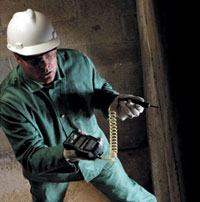By Mandy Sunderland, Industrial Hygiene Specialist, Total Safety
 In response to concerns over new toxicological data on the effects of chronic exposure to hydrogen sulfide (H2S), the American Conference of Governmental Industrial Hygienists (ACGIH) has voted to substantially reduce their recommended exposure limits for H2S. They have dropped their 8 hour time weighted average Threshold Limit Value (TLV-TWA8) for H2S from 10 ppm to 1 ppm, and their Short Term Exposure Limit (TLV-STEL) from 15 ppm to 5 ppm. Unfortunately, most H2S measurement and monitoring equipment currently available for use in the workplace isn’t accurate in the 1 ppm range. Confirming compliance with the new standards will be a challenge for health and safety practitioners.
In response to concerns over new toxicological data on the effects of chronic exposure to hydrogen sulfide (H2S), the American Conference of Governmental Industrial Hygienists (ACGIH) has voted to substantially reduce their recommended exposure limits for H2S. They have dropped their 8 hour time weighted average Threshold Limit Value (TLV-TWA8) for H2S from 10 ppm to 1 ppm, and their Short Term Exposure Limit (TLV-STEL) from 15 ppm to 5 ppm. Unfortunately, most H2S measurement and monitoring equipment currently available for use in the workplace isn’t accurate in the 1 ppm range. Confirming compliance with the new standards will be a challenge for health and safety practitioners.
ACGIH TLV’s reflects industry consensus on the level of exposure a typical worker can experience without unreasonable risk of disease or injury. Unlike Permissible Exposure Limits (PEL’s) set by the Occupational Safety and Health Administration (OSHA), TLV’s are voluntary standards and not enforceable by law. However, most employers adopt them in order to help ensure maximum protection of employees in the workplace.
So what’s the stink about H2S?
Hydrogen sulfide is an extremely toxic and irritating gas. It has a strong odor of rotten eggs at low concentrations, but deadens the sense of smell at higher concentrations, which can mask its presence. Inhalation of 500-1000 ppm will cause rapid unconsciousness and death through respiratory paralysis and asphyxiation. Inhalation of low concentrations may cause headache, dizziness and upset stomach. Even at concentrations under 5 ppm, metabolic changes and increased anxiety have been reported in people who are exercising.
Three primary types of instruments are used to detect and monitor H2S exposures: fixed area detectors, portable area detectors, and personal detectors. Fixed area detectors alert operators to leaks and releases in the workplace and have typically been set to alarm at concentrations of 10 to 15 ppm. Portable area detectors are used to test confined spaces and general work areas to confirm elevated levels of H2S are not present. Personal detectors are worn by employees and will sound an audible alarm at levels of 10 to 15 ppm. A wide variety of reliable and well regarded H2S detectors which measure and alarm in the 10 ppm range are available to industry. However, there is limited availability of detectors which operate accurately in the 1 ppm range.
In November 2009, in anticipation of the new ACGIH reduced exposure limits for H2S, the Canadian Association of Petroleum Producers (CAPP) completed an extensive report entitled a Feasibility Study on Responding to a Lower Hydrogen Sulfide Exposure Limit for Workers. This study identified some limited options for commercially available equipment that measure H2S to 1 ppm. While this measurement technology exists, not all of it is feasible for use in the workplace, or considered to be consistently sensitive enough to measure concentrations at 1 ppm. Validated methods listed in the study include a Colorimetric Detector Tube system to measure TLV-TWA8 and Electrochemical Sensor Meters for use as personal detectors. Of the six portable detectors listed, only two are feasible for use in the workplace. Gold Film detectors appeared promising, but are not suitable for use in hazardous locations.
So where does that leave the safety and health practitioner? Most of us will have to continue to rely on current detector technology which may not provide reliable and accurate measurements at the new TLV’s while we wait for innovations from manufacturers and suppliers. On the practical side, if there are known concentrations of H2S in the workplace, we can take extra precautions to minimize worker exposures by installing engineering controls and taking prompt action in response to leaks and alarms. Common sense and good judgment, combined with smart use of existing technology, will enable us to continue to provide adequate protection to the workforce until the next generation of H2S detection and monitoring equipment arrives.
For more information on Total Safety and how we can equip your company with the best in H2S protection and safety services, give us a call at 888.44.TOTAL.
Total Safety – The Best Minds in the Business!








